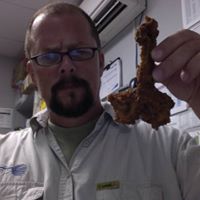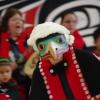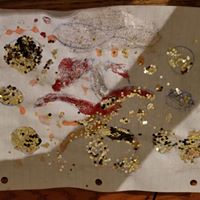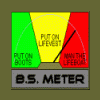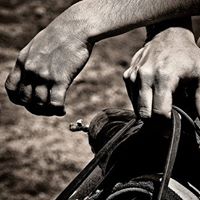
BAYAMedic
EMT City Sponsor-
Posts
142 -
Joined
-
Last visited
-
Days Won
10
BAYAMedic last won the day on May 30 2015
BAYAMedic had the most liked content!
About BAYAMedic
- Birthday 07/10/1985
Previous Fields
-
Occupation
Paramedic
Profile Information
-
Gender
Male
-
Location
Eastern WA
Recent Profile Visitors
16,305 profile views
BAYAMedic's Achievements
Newbie (1/14)
45
Reputation
-
Sorry I missed out on this thread until now. Fireman1037 a lowly volly emt became BAYAMedic then a Battalion Chief EMS manager and solo paramedic serving a rural county. After a couple years of that, I have had a bit of a breakdown and now am looking to a new start in which direction to go. You asked about reunions, My self and Eyedawn won the Rob Davis Memorial scholarship and went to CAP lab. Dwayne met us out there. That was in 2011. Each of us independently chose to go back in 2014 and had a nice reunion. Oh, Chris was there too. That crazy Canadian Emt turned Doc. BAYAMedic
-
"The best thing I think you should do is this, get a scanner, listen to it and when you hear a fire call, go to the station, wait till the call is over, wait for them to come back and then go up to the captain or the chief, he will be one of the guys, probably the one with the cleanest shirt, you will just have to ask to speak to him and then ask him the question you are asking us." Holy run on sentence Ruffles! Rather than purchasing a scanner, look at the broadcastify.com and click on your site, county and see if your local fire dispatch is streaming. A lot of places have switched to a digital narrowband frequency that the entry level scanners wouldn't pick up. There are a ton on eBay that should work and Baofeng brand are all in the $40 range. As I told you in the other thread, I started at 16. There wasn't a structured program or a policy and procedure book. As time went on, and my experience and knowledge base broadened, my scope of duties expanded. That Department's insurance wouldn't allow a driver under 21 or 25, so on a fire truck I rode in the hydrant seat so when we got to the fire, I would jump out with the hydrant kit and would attach and flow water on the engineers command. Then I would work with the incident commander, manage the accountability/password board,scribing and watching the air clock to know when the interior crew is getting low on their Air tank pressure.
-
*Edited to finish post, after accidentally posting* We all have different experiences. Much of the exposure/experience you may receive, will vary greatly, depending on your locale. This is my experience only, offer is void where prohibited, no warranty is implied or expressed, always follow your local protocols, and local, state, and federal laws where applicable. I receive no compensation for any product recommendation, The opinions expressed herein are my own and may not represent or reflect the position of any company/department of which I am currently or previously affiliated, results not typical, etc. On my 16th birthday, I was working my summer job at a roadside fruit stand and bakery. We had just say down to enjoy birthday cake, between tourist buses, when a Chrysler Concord rolled up in front of the shop. It parked perpendicular to the way the stripes were, and started honking his horn. I remember joking "What does this guy want, drive up service?" I put on my best customer service smile and opened the door. In the drivers seat sat a 300ish pound, 60's year old guy. He was flushed and sweaty. He gasped "I need help" I called 911 and EMS was dispatched. He said "I think I am having a heart attack." This was back when the Bayer aspirin commercials had just started, so we dug out the first aid kit and gave him two adult aspirin. The ambulance barn was 8.5 miles away, with volunteer staffing, so what was likely 15 minute response that felt like an hour. I felt totally and completely helpless and wanted to help this poor guy, but didn't know what more I could do. One of the owners of the fruit stand was a captain of the local fire department, which also is a Ambulance service. He suggested that since I was now 16, I should become a Jr. Firefighter. Never wanting to feel that helpless again, I agreed. That Thursday night was my first fire drill. I remember searching through the station attic and finding my first set of turnouts and trainee helmet, They were 20+ years old when they were issued to me. I also found a pair of nomex coveralls and leather gloves, wildland fire helmet and belt for fire shelter. We ordered a pair of wildfire boots, which were the only equipment I received that wasn't "hand me downs." This was a very small department, where only the officers had radios, and a few had Motorola voice pagers. The rest of us found out we had a call, by the 2 minute air raid sirens blaring and responding to the station. We had a mini academy to get myself and one other recruit to a functional level. This opportunity gave me exposure to public service, and I loved every minute of it. I had spent nearly every Saturday from November-March at a local ski hill, since I was in 1st grade. One of my friend's dad had been on the volunteer ski patrol for ages and talked me into joining as a Jr Patrol Candidate. The "Outdoor Emergency Care Technician" course by AAOS was based on the EMT course and met the DOT requirements. This gave me a foot in the door to expand my medical knowledge base and allowed me to network with other healthcare professionals. The ski hill medical program director, was an ER physician and fellow patrolman, graciously offered to allow me to shadow him in ER. Through ny high school, I was able to secure a "school to work" internship at the ER, and was able to collect both school "elective" credits, and could rack up community service hours for my Senior project. I had completed all of the required classes at the school, and simply needed credit hours to graduate. A few weeks into this, I realized the really interesting cases were coming in via the ALS ambulance service, so I approached the company and the school to see about ambulance ridealongs. The fall and winter of my senior year were spent M-F 8-5 on the Ambulance, and a mixture of weekends at the ski hill or the ER. During this time a First Responder (now called Emergency Medical Responder) class became available, so I took that class, as I hadn't graduated school yet so was ineligible for EMT. I logged over 1,000 community service hours between the internships, ski patrol and fire department, and qualified for and won the Presidential Freedom Scholarship for Volunteering. These experiences gave me a laser focused plan on what direction I wanted to go after graduation. I took my official EMT class that fall of 2004. Since that time I have worked or interned in many styles of EMS Systems: Fire based transport, Fire based first response, Private for profit, Private non-profit, Industrial non-transport at an underground Zinc mine, BLS event standby, BLS non-emergent transfer, ALS rendezvous, and even some time doing wheelchair van/Cabulance. I have been in and out of the industry a couple times, but have been active this time since 2009 when I began a degree track Paramedic school, and am currently a Paramedic Battalion Chief for a rural Fire department that transports 50+ minutes to critical access hospitals and 90 minutes to a Level II Trauma center. I was a total nerd in high school, and didn't really fit in. I found a camaraderie and friends in Fire/EMS that I didn't have with school. That being said, the others are absolutely right, you only get to do high school once. You have your whole life to enjoy a career of your choosing. Lastly, academically, push your self in the sciences, a functional understanding of Biology, Chemistry, Psychology, Communication and English Composition are tools you will use everyday as a Paramedic.
- 9 replies
-
- 1
-

-
- EMTParamedic
- Prehospital
-
(and 1 more)
Tagged with:
-
Every EMS library should have 1. Rin-tin-tinalli's "Emergency Medicine" 2. Dale Dubins "Rapid interpretation of EKG's 3. Pathophysiology by Copstead and Banasik (sharing some love for a local author and great text) 4. Nancy Caroline's "Emergency Care in the Streets" preferably an old edition and a new one, to compare how evolutionary EMS is. 5. The full 7 book Brady series, Paramedic Care by Bledsoe, Porter, et all. 6. "Paramedic Emergency Care" by Bledsoe 1997 edition for those days you don't want to have a full reference library in your backpack. (See #5) 7. "A paramedics story: Life, Death and everything in between" Steven "Kelly" Grayson. Just an overall great read. 8. "Emergency Laughter" by Mike Cyra ( a quick, easy read to fix a bad mood) and I haven't seen him post in a while, but a EMTCity local... 9. THE 1966 White paper "Accidental Death and Disability: The neglected disease of Modern Society" ('cause know your roots!) 10. Last but far from least, the wee little books: a PDR/Terrascon pocket pharmacopeia, IRPG, Hazmat Emergency Response guide. Bayamedic aka Medic 203
-
BAYAMedic started following Endotracheal Intubation vs. King LT and Quality books?
-
I think I'm a........gasp......whacker!
BAYAMedic replied to Arctickat's topic in General EMS Discussion
Whacker is as whacker does. No one could smack one down quite like Rob/Dusty, yet he was a huge scanner land listener. Your good Kat.... Medic203/ Bayamedic -
I am a fan of Haix boots. I am currently wearing my third pair. Haixusa.com is the site I use and the factory seconds/ clearance always seem to have a decent deal with periodic additional sales from the email list. Currently an additional 30% off with coupon code. Bayamedic
-
I purchased 2 CombiCarrier II backboards this spring for this exact reason. Still function as a LBB if "needed" but allow you to use the same muscle memory to board a patient, (no one up here had used clamshells) and two clasps later they are off the board and on the cot mattress. The big downside was the cost at just over $800USD each. BayaMedic
-
I love my Leatherman Rebar. I was given a pair of Leatherman Raptor shears that live in the center console of my command rig but are a touch bulky for belt space and I don't like wearing stuff in ems pants cargo pockets. BayaMedic
-
Chappy, remember your STEMI foolers, BLEPPP. One is present in this tracing and DR Lifepak picked it up too. ***Personal experience alert*** I had a Stemi Code who was revived after 1 shock. He became A&O within 5-10 minutes post arrest. When he arrested he fell to the ground from standing and had a small raspberry on his forhead. I withheld ASA for fear of head bleed. I was told by the receiving physican "Treat what you know. You know he has a STEMI, the head will require a scan and is only a maybe. Treat what you know. 324mg ASA!" BAYAMedic
-
Ok it is late so I am shooting from the hip Doc. From what we know about apneic oxygenation from the dog labs and needle cricothyrotomy. And the results of NODESAT of high flow nasal cannulas utilizing saturation gradient apneic oxygenation during ETI/RSI. And the diminished venous return do to increased intrathorassic pressures with ET/SGA placement, to eliminate any Starling pressures possible, when do we say throw a NRB at 25LPM (or cannula with capnography to catch moment of ROSC), focus entirely on CPR and zip in an IO for EPI? Its late, pardon the scattered thoughts. BAYAMedic
-
Doc, Yes LMA have been used in OR a lot. But that is a far more controlled setting. Only after 6-8 hours fasting, with no history of reflux, when ETT has been used in less controlled airways for ages. BayaMedic
-
*Anecdote alert* My experiences are strictly that. I have personally never used a King LT but have intercepted calls with one in place. One was a STEMI --> witnessed VFib arrests x6 (NSR following single 300j shock) patient had failed Ett placement x2 and a King was placed. King was removed on ER arrival and replaced with ETT. Pt released Neurologically intact without deficits and came by the station 2 weeks later. The second was a GSW to the head and after failed attempts a KING was placed. Patient was overdriving the vent and was left in place during organ harvest. Every cardiac arrest I have been directly been involved in, have had ETT placed with one exception of a surgical Cricothyrotomy. This comes from having cut my teeth as a paramedic in a system in Washington State (that had arrest survival rates nearly mirroring King County Medic One), that utilizes a strict cardiac arrest QA/QI process, and intubation is the only advanced airway used. Kings are available but each paramedic in this system averages 15 intubations per year. Airway mannequin time is encouraged and OR time is mandatory with any multiple intubation failure. This stringent QA QI process promotes paramedic Advanced airway competency and RSI with offline protocol. We have Resuscitation University Faculty as our MPD and CPR Quality Audits, therefore any intubation attempt will be during compressions. Like I stated in the beginning this is all anecdotal but this is what I know. Didn't the Japanese study show poorer outcomes with SGA due to Carotid/Jugular impingement from the cuff limiting Cerebro blood flow? BAYAMedic
-
As several of you know, I am about 6 months into my dream job. I am the sole Paramedic& EMS Battalion Chief of a very rural agency. The closest ER is a PA staffed Level 4 critical access hospital, at 45 miles and a physician staffed level 3 with no Cath lab. The closest Cath lab is 100 Miles away This agency receives 300ish calls per year, Due to a generous annual donation by a hydroelectric dam in the coverage area, this agency has one paramedic on staff and a volunteer BLS support staff. We cover 750 square miles of mountainous terrain in the extreme NE of Washington state. "The Paramedic" (weird to have it be a title rather than level of training), has traditionally had a Fly car for ALS Rendezvous/Fire Command. Looking through the old records it has been a variety of vehicles including: a Aerostar van, K5 Blazer, a 1990 Suburban, a 2001 Dodge Durango, 2004 Chevy Tahoe, 2009 Expedition, 2005 F-250 (with slip-in fire tank/pump). We serve a fair amount of forest service land with seasonal access and support several Search and rescue missions per year. The problem I have ran into over the last 6 months, is that our two Primary Ambulances are beautiful Type 1 Ford F350 BraunNW Northstar Ambulances, with 167" wheel base, and 75" floor to Ceiling in the back. While they have been providing excellent transport capabilities, with the nature of our very mountainous terrain, there have been problems getting to some of the patients and the boxes have thus far gotten away with only minor damage. I say all this to set the stage for my question. I currently have been approved to purchase a replacement vehicle, that has patient transport capabilities, Odyssey has a cabinet system designed for SUV patient transport and I like it so far, but have only seen a handful of pictures, and haven't had a chance to talk to anyone actually using them. The vehicle I am looking at is a 2015 Ford Police Interceptor Utility and that cabinet system has been installed and utilized by one agency, but again, I haven't been able to contact them. I ask this question to all of you: If you were to design your Dream Fly car with patient transport capabilities, what would you choose, how would you lay it out, and lastly what color would you paint it and how would you stripe and sticker it? http://www.odysseyauto.com/cabinets/ems-40-60-t1r.html Fireman1037 AKA BAYAMedic and newly dubbed "Command Medic 203" chappaqua pics.pdf
- 3 replies
-
- Fly car
- Interceptor
-
(and 3 more)
Tagged with:
-
Stump the Chump/medic: IV Opioids AND IV Alcohol
BAYAMedic replied to croaker260's topic in Patient Care
Vodka would be good at a 50% water to 50% alcohol to get the best of both worlds. While I don't know about the solubility of narcotics in alcohol, I read in a druggie forum it takes about 1.8 mL of water per oxycontin tab to get the best cold water extraction. If they can achieve more with the alcohol and have a easier access to "sterility" vs what comes out of the tap, I can see how this would be an interesting logical move for your local IV Drug Users. BayaMedic -
I seem to remember reading somewhere, that there was a study done that took into account pre-hospital Metoprolol and the outcomes showed no positive effects if given pre-hospitally, provided it was given within the first 24 hours. We had it previously and had it removed from our protocols. BAYAMedic


